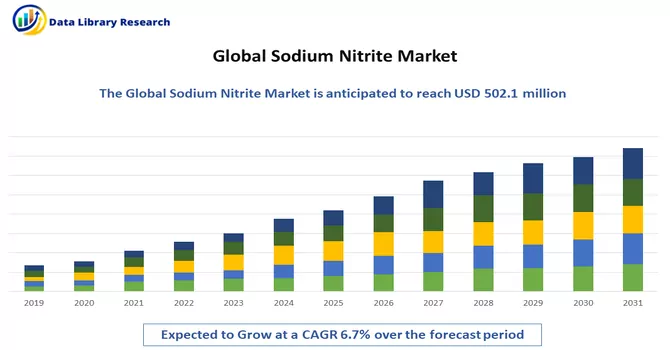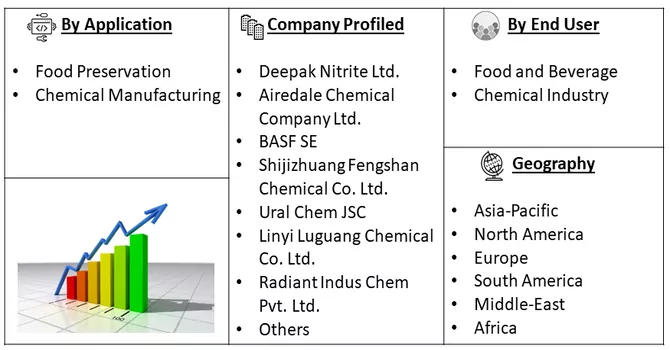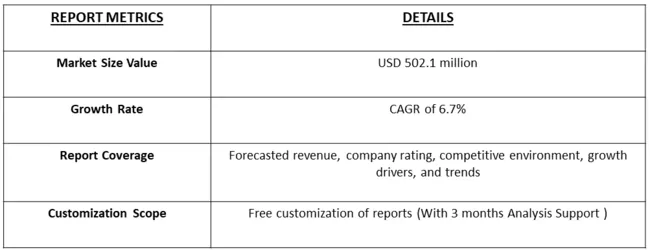The global sodium nitrite market is valued to be worth USD 502.1 million in 2024 and is expected to grow at a CAGR of 6.7% over the forecast period, 2024-2031.

Get Complete Analysis Of The Report - Download Free Sample PDF
Sodium nitrite (NaNO2) is a chemical compound composed of sodium, nitrogen, and oxygen. It is a white to slightly yellowish crystalline powder that is soluble in water. Sodium nitrite is commonly used in various industrial applications, including food preservation, where it functions as a curing agent for meats, preventing the growth of bacteria and preserving the color of the meat. In addition to its role in the food industry, sodium nitrite has applications in the production of dyes, pharmaceuticals, and other chemicals. It is important to note that while sodium nitrite has specific uses, its handling requires caution, as it can pose health risks if not used properly.
The sodium nitrite market is experiencing robust growth driven by the increasing demand for food preservation solutions in the global food industry. As a key curing agent, sodium nitrite plays a pivotal role in preserving processed meats, aligning with the rising preference for convenience and processed food products. The expanding meat processing industry, coupled with technological advancements in food processing and packaging, further propels the market's upward trajectory. Additionally, heightened awareness of food safety, globalization of the food trade, and the compound's versatile applications beyond the food sector contribute to its widespread use. Ongoing research and development activities, regulatory support, and compliance with safety standards also foster market expansion. With its crucial role in preventing bacterial growth and extending the shelf life of perishable goods, sodium nitrite continues to be a vital component in various industries, making it an essential factor in the market's sustained growth.
The studied market’s recent trends in the sodium nitrite market include a notable shift towards nitrite-free alternatives and clean label products, driven by consumer preferences for natural and transparent food labeling. Technological innovations in food preservation methods, such as high-pressure processing, have contributed to a reduced reliance on traditional preservatives like sodium nitrite. Global regulatory changes regarding the use of sodium nitrite, particularly in response to health concerns, impact market dynamics and influence its utilization in different regions and industries. The rising popularity of organic and natural foods has prompted food manufacturers to explore alternative preservation methods that align with organic certifications, impacting the sodium nitrite market. Additionally, the growing importance of food safety, market expansion in developing regions, and the diversification of sodium nitrite's applications beyond the food industry contribute to the evolving landscape of this market.
Market Segmentation: The Sodium Nitrite Market is Segmented by Application (Food Preservation, and Chemical Manufacturing), End User Industry (Food and Beverage and Chemical Industry), and Geography (North America, Europe, Asia-Pacific and Rest of the World). The report offers market size and forecasts in terms of value (USD million) for all the above segments.

For Detailed Market Segmentation - Download Free Sample PDF
Market Drivers:
Growing Food Industry Demand
A primary catalyst propelling the sodium nitrite market is its widespread application in the food industry, specifically as a vital curing agent for processed meats. The surging consumer demand for preserved and processed meat items such as bacon, sausages, and ham significantly amplifies the reliance on sodium nitrite as an indispensable component for food preservation. This compound plays a pivotal role in not only extending the shelf life of these processed meat products but also ensuring their safety for consumption. The enduring popularity of sodium nitrite in the food industry underscores its critical function in meeting the persistent consumer preferences for convenient and shelf-stable meat options while maintaining high standards of food safety and quality.
Escalating worldwide consumption of processed and convenient foods
The surge in global consumption of processed and convenient foods, influenced by evolving dietary habits and the pervasive trend of urbanization, stands out as a significant driving force behind the increasing demand for sodium nitrite. This trend is particularly pronounced in the context of processed meats, which remain highly favored among consumers. Sodium nitrite emerges as a pivotal player in this scenario, playing an indispensable role in preserving these processed meat products. Beyond merely extending the shelf life of such items, sodium nitrite assumes a critical function as a safeguard, ensuring that processed meats maintain high standards of safety and quality for consumption. Its continued prominence is underscored by its adaptability to the prevailing shift towards processed and convenient food choices globally, highlighting its essential role in meeting the evolving preferences of contemporary consumers who seek both convenience and food safety assurance in their dietary selections.
Market Restraints:
Health Concerns and Regulatory Scrutiny
The growing recognition of potential health risks linked to the excessive consumption of sodium nitrite, particularly the formation of nitrosamines, has triggered heightened regulatory scrutiny. This increased awareness has prompted regulatory authorities to impose more stringent regulations and limitations on the inclusion of sodium nitrite in food products. The implementation of stricter guidelines is driven by concerns surrounding the formation of nitrosamines, compounds that have been associated with adverse health effects. These regulations, while prioritizing consumer safety, concurrently pose challenges to the sodium nitrite market by placing restrictions on its usage in the food industry. Navigating these regulatory constraints necessitates industry adaptation, emphasizing the importance of developing alternative solutions, improving production processes, and ensuring compliance with evolving standards to mitigate potential market limitations.
The sodium nitrite market faced notable impacts amid the COVID-19 pandemic as the global disruptions to supply chains, shifts in consumer behavior, and economic uncertainties reverberated through various industries. The closure of restaurants, food service establishments, and disruptions in meat processing plants led to a decline in the demand for processed meats, a key application for sodium nitrite. Fluctuating raw material prices, logistical challenges, and labor shortages further affected production and distribution, influencing the overall sodium nitrite market dynamics. Moreover, the heightened focus on health during the pandemic spurred a growing interest in clean label and natural food products, posing challenges for sodium nitrite, which has faced scrutiny for potential health risks. As the food industry adapts to changing consumer preferences and the aftermath of the pandemic, sodium nitrite manufacturers are navigating a landscape marked by both challenges and opportunities, emphasizing the need for resilience and innovation in the post-COVID-19 era.
Segmental Analysis:
Chemical Manufacturing Segment is Expected to Witness Significant Growth Over the Forecast Period
The sodium nitrite market intersects significantly with chemical manufacturing, playing a pivotal role as a versatile compound with diverse applications within the chemical industry. One of the primary uses lies in the production of various chemicals, including dyes and pharmaceuticals. Sodium nitrite serves as a key precursor in the synthesis of these chemical compounds, contributing to the vibrant coloration of dyes and the formulation of pharmaceutical products. Its chemical properties make it valuable in reactions that yield a range of compounds utilized across different industrial processes. The demand for sodium nitrite in chemical manufacturing underscores its importance as a reagent and intermediary, facilitating the creation of essential components in numerous end-products. Additionally, sodium nitrite's role in chemical processes aligns with the broader industrial need for efficient and reliable chemical agents, further solidifying its position as a significant component in the chemical manufacturing landscape. The symbiotic relationship between sodium nitrite and chemical manufacturing reflects its indispensable nature in driving innovation and production efficiency within this dynamic sector.
Food and Beverages Segment is Expected to Witness Significant Growth Over the Forecast Period
The sodium nitrite market holds a crucial position within the food and beverage industry, primarily owing to its indispensable role as a curing agent and preservative in processed meats. Widely used in the preservation of products such as bacon, sausages, and ham, sodium nitrite plays a vital function in extending the shelf life of these processed meats while ensuring their safety for consumption. The compound effectively inhibits bacterial growth, preventing spoilage and maintaining the color and flavor of the meat products. Despite its widespread use, there is a growing awareness of potential health risks associated with excessive sodium nitrite consumption, particularly the formation of nitrosamines. This has led to increased regulatory scrutiny, prompting the industry to explore alternative preservatives. However, sodium nitrite remains a key player in the food and beverage sector, offering a practical solution for enhancing the preservation and overall quality of processed meats. Its unique properties continue to position it as a critical ingredient, balancing the necessity for food safety with the challenges posed by evolving consumer preferences and regulatory landscapes within the dynamic food and beverage market.
North America Region is Expected to Witness Significant Growth Over the Forecast Period
The sodium nitrite market in North America reflects a dynamic landscape influenced by various factors, including the region's robust food industry, industrial applications, and regulatory considerations. As a key player in the food sector, sodium nitrite finds extensive use as a curing agent for processed meats, aligning with the region's high consumption of meat products. The compound's role in preserving processed meats and preventing bacterial growth is particularly significant in the context of the region's evolving dietary patterns and preferences for convenient, packaged foods. Furthermore, the chemical manufacturing sector in North America contributes to the demand for sodium nitrite, utilizing it in the production of dyes, pharmaceuticals, and other chemical compounds. The market is also shaped by regulatory standards that govern the use of sodium nitrite, with a focus on ensuring food safety and mitigating health risks associated with excessive consumption. The sustainability trend and the exploration of alternative preservatives also impact the sodium nitrite market in North America. Overall, the sodium nitrite market in North America is characterized by a balance between its crucial role in food preservation, industrial applications, and the need to address evolving consumer preferences and regulatory dynamics in the region.

Get Complete Analysis Of The Report - Download Free Sample PDF
The analyzed market exhibits a high degree of fragmentation, primarily attributable to the presence of numerous players operating on both a global and regional scale. The competitive landscape is characterized by a diverse array of companies, each contributing to the overall market dynamics. This fragmentation arises from the existence of specialized solution providers, established industry players, and emerging entrants, all vying for market share. The diversity in market participants is underscored by the adoption of various strategies aimed at expanding the company presence. On a global scale, companies within the studied market are strategically positioning themselves through aggressive expansion initiatives. This often involves entering new geographical regions, targeting untapped markets, and establishing a robust global footprint. The pursuit of global expansion is driven by the recognition of diverse market opportunities and the desire to capitalize on emerging trends and demands across different regions. Simultaneously, at the regional level, companies are tailoring their approaches to align with local market dynamics. Regional players are leveraging their understanding of specific market nuances, regulatory environments, and consumer preferences to gain a competitive edge. This regional focus allows companies to cater to the unique needs of local clientele, fostering stronger market penetration. To navigate the complexities of the fragmented market, companies are implementing a range of strategies. These strategies include investments in research and development to stay at the forefront of technological advancements, mergers and acquisitions to consolidate market share, strategic partnerships for synergies, and innovation to differentiate products and services. The adoption of such multifaceted strategies reflects the competitive nature of the market, with participants continually seeking avenues for growth and sustainability. In essence, the high fragmentation in the studied market not only signifies the diversity of players but also underscores the dynamism and competitiveness that drive ongoing strategic maneuvers. As companies explore various avenues for expansion, the market continues to evolve, presenting both challenges and opportunities for industry stakeholders.
Some of the key market players working in this segment are:
Recent Development:
1) In May 2023, BASF launched a pioneering pilot project titled "climate-smart meat" in partnership with Danish Crown, a leading pork product producer in Europe. The primary objective of this initiative is to demonstrate the effectiveness of BASF's nitrification inhibitors in reducing nitrous oxide emissions by up to 50% when integrated into fertilizers used for cultivating feed crops. This innovative approach translates into a noteworthy 3-5% reduction in the carbon footprint per kilogram of pork. The project encompasses the participation of 84 farmers managing over 20,000 hectares in Denmark, signifying a substantial scale that is poised to influence the nitrite market positively throughout the forecast period.
2) In July 2022, BASF SE joined forces with Häffner GmbH & Co. KG to establish a collaborative distribution partnership aimed at marketing Sodium Nitrate and Nitrite in quantities below 20 tonnes. This strategic collaboration reflects BASF's commitment to expanding its market presence and optimizing the distribution of sodium nitrate and nitrite, further solidifying its position in the industry.
Q1. What is the current Sodium Nitrite Market size?
As per Data Library Research the global sodium nitrite market is currently valued to be worth USD 502.1 million.
Q2. At what CAGR is the Sodium Nitrite Market projected to grow within the forecast period?
Sodium Nitrite Market is expected to grow at a CAGR of 6.7% over the forecast period.
Q3. What are the factors driving the Sodium Nitrite Market?
Key factors that are driving the growth include the Growing Food Industry Demand and Escalating worldwide consumption of processed and convenient foods.
Q4. Which Region is expected to hold the highest Market share?
North America region is expected to hold the highest Market share.
Data Library Research are conducted by industry experts who offer insight on industry structure, market segmentations technology assessment and competitive landscape (CL), and penetration, as well as on emerging trends. Their analysis is based on primary interviews (~ 80%) and secondary research (~ 20%) as well as years of professional expertise in their respective industries. Adding to this, by analysing historical trends and current market positions, our analysts predict where the market will be headed for the next five years. Furthermore, the varying trends of segment & categories geographically presented are also studied and the estimated based on the primary & secondary research.
In this particular report from the supply side Data Library Research has conducted primary surveys (interviews) with the key level executives (VP, CEO’s, Marketing Director, Business Development Manager and SOFT) of the companies that active & prominent as well as the midsized organization
FIGURE 1: DLR RESEARH PROCESS

Extensive primary research was conducted to gain a deeper insight of the market and industry performance. The analysis is based on both primary and secondary research as well as years of professional expertise in the respective industries.
In addition to analysing current and historical trends, our analysts predict where the market is headed over the next five years.
It varies by segment for these categories geographically presented in the list of market tables. Speaking about this particular report we have conducted primary surveys (interviews) with the key level executives (VP, CEO’s, Marketing Director, Business Development Manager and many more) of the major players active in the market.
Secondary ResearchSecondary research was mainly used to collect and identify information useful for the extensive, technical, market-oriented, and Friend’s study of the Global Extra Neutral Alcohol. It was also used to obtain key information about major players, market classification and segmentation according to the industry trends, geographical markets, and developments related to the market and technology perspectives. For this study, analysts have gathered information from various credible sources, such as annual reports, sec filings, journals, white papers, SOFT presentations, and company web sites.
Market Size EstimationBoth, top-down and bottom-up approaches were used to estimate and validate the size of the Global market and to estimate the size of various other dependent submarkets in the overall Extra Neutral Alcohol. The key players in the market were identified through secondary research and their market contributions in the respective geographies were determined through primary and secondary research.
Forecast Model
